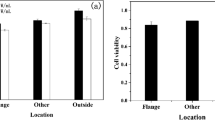Abstract
Worldwide, humans are exposed to a mean background radiation dose of about 2.4 mSv per year. Natural background radiation is a constant and ubiquitous environmental factor affecting all living things on this planet, and organisms have evolved in the presence of the natural radiation since the first forms of life appeared on Earth. However, its role in biology is still not completely understood. Here, we summarize the interesting biological responses in organism at below-background radiation and highlight recent development of the studies with molecular based analyses. To date, deprivation of natural background radiation has been carried out with shielding chambers or by conducting experiments in underground laboratories. In recent decades some research groups have reported changes to growth-related biological endpoints in microorganisms and mammalian cells under low-background radiation conditions. Moreover, new technologies, such as DNA microarray and next-generation sequencing, have begun to shed fresh light on the molecular mechanisms of these biological phenomena. Although there is no consistent explanation for the mechanisms so far, such studies might provide clues toward an understanding of the biological responses to natural background radiation.

Similar content being viewed by others
References
Castillo H, Schoderbek D, Dulal S, Escobar G, Wood J, Nelson R, Smith G. Stress induction in the bacteria Shewanella oneidensis and Deinococcus radiodurans in response to below-background ionizing radiation. Int J Radiat Biol. 2015;91(9):749–56. https://doi.org/10.3109/09553002.2015.1062571.
Castillo H, Li X, Schilkey F, Smith G. Transcriptome analysis reveals a stress response of Shewanella oneidensis deprived of background levels of ionizing radiation. PLoS ONE. 2018;13(5):e0196472. https://doi.org/10.1371/journal.pone.0196472.
Conter A, Dupouy D, Planel H. Demonstration of a biological effect of natural ionizing radiations. Int J Radiat Biol Relat Stud Phys Chem Med. 1983;43:421–32.
Croute F, Dupouy D, Charley P, Soleilhavoup P, Planel H. Effects of autogamy in Paramecium tetraurelia on catalase activity and on radiosensitivity to natural ionizing radiations. J Protozool. 1980;27:132–5.
Croute F, Soleilhavoup P, Vidal S, Dupouy D. Planel H. Paramecium tetraurelia growth stimulation under low-level chronic irradiation: investigations on a possible mechanism. Radiat Res. 1982;92:560–7.
Fratini E, Carbone C, Capece D, Esposito G, Simone G, Tabocchini A, et al. Low-radiation environment affects the development of protection mechanisms in V79 cells. Rad Environ Biophys. 2015;54:183–94.
ICRP. Recommendations of the international commission on radiological protection. Oxford: Pergamon Press; 1959.
ICRP. Recommendations of the International Commission on Radiological Protection. Oxford: Pergamon Press; 1990.
Kawanishi M. Molecular mechanism of growth retardation of mouse cells by shielding them from background radiation, JSPS Final Research Report of Grants-in-Aid for Scientific Research. 2015. (in Japanese).
Kawanishi M, Okuyama K, Shiraishi K, Matsuda Y, Taniguchi R, Shiomi N, Yonezawa M, Yagi T. Growth retardation of Paramecium and mouse cells by shielding them from background radiation. J Radiat Res. 2012;53:404–10.
Lampe N, Breton V, Sarramia D, Sime-Ngando T, Biron DG. Understanding low radiation background biology through controlled evolution experiments. Evol Appl. 2017;10:658–66.
Planel G, Soleilhavoup P, Tixador R, Croute F, Richoilley G. Demonstration of a stimulating effect of natural ionizing radiation and of very low radiation doses on cell multiplication. In: IAEA-SM-202/205. 1976. p 127–140.
Planel H, Soleilhavoup P, Tixador R, Richoilley G, Conter A, Crouter F, Caraterp C, Gaubin Y. Influence on cell proliferation of background radiation or exposure to very low, chronic gamma radiation. Health Phys. 1987;52:571–8.
Richoilley G, et al. Preliminary results of the “Paramecium” experiment. Naturwissenschaften. 1986;73:404–6.
Satta L, Agusti-Tocco G, Ceccarelli R, Esposito A, Fiore M, Paggi P, Poggesi I, Ricordy R, Scarsella G, Cundari E. Low environmental radiation background impairs biological defence of the yeast Saccharomyces cerevisiae to chemical radiomimetic agents. Mutat Res. 1995;347:129–33.
Satta L, Antonelli F, Belli M, Sapora O, Simone G, Sorrentino E, et al. Influence of a low background radiation environment on biochemical and biological responses in V79 cells. Radiat Environ Biophys. 2002;41:217–24.
Takizawa Y, et al. Background radiation can stimulate the proliferation of mouse-L-5178Y cells. In: Proceedings of international conference on radiation effects and protection. 1992. p 234–236.
Tubiana M. Dose-effect relationship and estimation of the carcinogenic effects of low doses of ionizing radiation: the joint report of the Academie des Sciences Paris and of the Academie Nationale de Medecine. Int J Radiat Oncol. 2005;63:317–9.
United Nations Scientific Committee on the Effects of Atomic Radiation (UNSCEAR). Sources and effects of ionizing radiation. In: Report to the General Assembly, with scientific annexes. New York: United Nations. 2000.
Funding
This work was supported by Grants-in-aid for Scientific Research (for Scientific Research (B): 15310042 and for challenging Exploratory Research: 25550035) from the Japan Society for the Promotion of Science (JSPS).
Author information
Authors and Affiliations
Corresponding author
Ethics declarations
Conflict of interest
The authors declare that they have no conflict of interest.
Additional information
This article is based on the presentation made during 18th All India Congress of Cytology and Genetics and International Symposium on “Translating Genes and Genomes” held at CSIR-Indian Institute of Chemical Biology, Kolkata in collaboration with Archana Sharma Foundation of Calcutta during January 29–31, 2018.
Rights and permissions
About this article
Cite this article
Kawanishi, M., Yagi, T. Exploration of biological phenomena of below-background natural radiation. Nucleus 62, 173–176 (2019). https://doi.org/10.1007/s13237-018-0254-7
Received:
Accepted:
Published:
Issue Date:
DOI: https://doi.org/10.1007/s13237-018-0254-7




